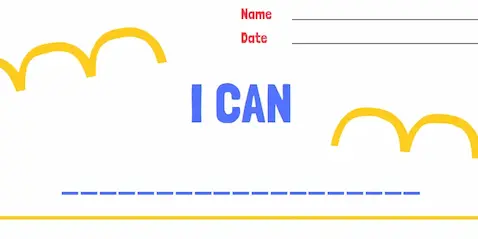This lesson draws on real classroom experience with Young Learners and is designed to be fun, effective, and easy to teach.
Main aim
The main aim of the lesson is to enable students to correctly identify and use modal verbs of ability “can” and “can’t”.
Materials
Here’s what we’ll need:
- One set of flashcards
- “I can” worksheet (one for each student)
- Crayons, markers or coloured pencils
Download the lesson plan and materials
The lesson
Here’s what to do in the different stages of the lesson:
Lead in and vocabulary
Ask a volunteer to come to the front of the class and pick a flashcard at random. (You don’t need the “thumbs up” and “thumbs down” flashcards for this.) Have the student show the flashcard very quickly to the class, and ask the class to guess the word or words that the card represents. You can model this first yourself with one of the cards, asking “What is on the card?” or just “What?”, showing it to the students and listening to all of the answers they shout out.
When someone shouts the word you’re looking for, say “Yes!”. If the students can’t guess a word, have the volunteer show the class the card again for a bit longer.
Discover all the vocabulary as a class and have different students participate until all of the vocabulary has been covered.
The vocabulary you’re looking for is:
- run
- jump
- swim
- walk
- turn around
- fly
- ride a bike
Presentation
Place the “thumbs up” (can) and “thumbs down” (can’t) flashcards on the board. Feel free to write “can” and “can’t” above or below each. Say “I can speak English!” or something equally simple and recognisable, followed by a big thumbs up. Ask the students as a group if they can speak English and allow them to shout back “Yes” or “No” as they wish.
Now say “I can’t speak [insert language here]” followed by a big thumbs down. If all your students have the same native language, you can say this language, with exaggerated facial expressions for effect! Ask the students if they can speak [insert language here] and allow them to shout back the answer. Continue the exercise with familiar abilities and write them under the “can” and can’t” flashcards on the board.
Now clear the board of the examples and introduce the flashcards once more. Start off by stating an ability in complete sentence form as an example to the class: “I can run”. Place the card under the thumbs up. Then ask the students “Can you run?”. Continue to do this with all of the flashcards where you think (based on the age of your students) that the answer will be “Yes”.
Show your students the “fly” flashcard. Say “I can’t fly” and place the card under the thumbs down. Ask the students if they can fly. If someone answers “Yes” (there is usually one!), you can ask them to demonstrate (in a safe, not-actual-flying way of course…) Moments like this are a fun way to change the dynamic of the class for a minute or two.
Restricted practice – Speaking
Divide your students into pairs. Each pair will ask “ability” questions to each other. Model this by stating an ability that you do and don’t have, preferably one that can’t be copied by the students, for example “I can drive a car” / “I can’t fly a plane”. You may want to set a certain number of questions for each if you are short of time (e.g. 2 can and 1 can’t).
Once the students have discovered an ability and inability, have them raise their hands to show you that they have finished. Ask for volunteers to come to the front of the class and share what they discovered that their partner can and can’t do.
Restricted practice – Writing / Drawing
Give each student a copy of the “I can…” worksheet and ask them to complete the sentence with the ability of their choice, and then draw it. Feel free to join in to show off your artistic (or non-artistic) ability as well. Joining in with activities in this way can help create a bond with your students.
Once their sentences and drawings are complete, have each student share their work with the class. If you lack resources (crayons, markers or pencils) or if you have time left over, you can play charades, with students acting out their ability for the rest of the class to guess.
———-
That’s it. Feel free to download a printable version of the whole lesson plan and all the materials.
Any comments, or suggestions of other ways to teach “can” and “can’t” to kids are welcome below.






